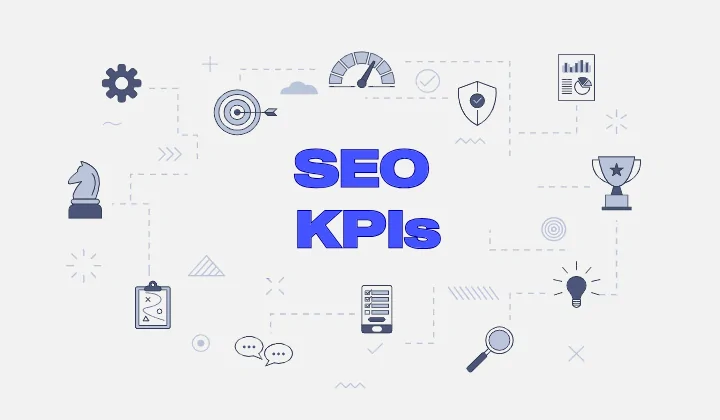What Are SEO KPIs for Measuring Success?

SEO KPIs for Measuring Success (Key Performance Indicators) are measurable values that serve as benchmarks for determining the success of your SEO strategy in achieving specific business objectives.
SEO KPIs for Measuring Success metrics provide critical insights into the performance of your organic search campaigns, enabling businesses to understand how well they are meeting their goals and where improvements are needed.
By monitoring these indicators, businesses can make informed, data-driven decisions to optimize their strategies for better results.
Tracking the right KPIs is pivotal for enhancing search visibility, driving quality traffic, and converting visitors into loyal customers.
Outlined below are 12 crucial SEO KPIs that every marketer should consistently monitor and measure to ensure the success and scalability of their SEO efforts.
- Organic Conversions
- Search Visibility
- Organic Traffic
- Click-Through Rate (CTR)
- Keyword Rankings
- Backlink Metrics
- User Engagement Metrics
- Customer Lifetime Value (CLV)
- Cost Per Acquisition (CPA)
- Non-Branded Traffic
- Return on Investment (ROI)
- Google Business Profile Metrics
1. Organic Conversions

Organic conversions measure the number of desired actions (e.g., purchases, form submissions, downloads) completed by users who arrive at your website through organic search channels.
This KPI provides invaluable insights into the effectiveness of your SEO strategy by linking it directly to measurable outcomes like revenue generation and lead acquisition.
Why Important SEO KPIs for Measuring Success:
- Reflects the quality of traffic your SEO strategy generates and its alignment with user intent.
. - Provides a direct connection between SEO performance and business growth objectives, ensuring your efforts translate into tangible results.
. - Highlights the success of targeted keywords and landing pages in driving meaningful actions.
.
How to Measure SEO KPIs for Measuring Success:
- Use Google Analytics or other analytics tools to set specific goals such as form submissions, e-commerce transactions, or lead generation activities.
. - Analyze conversion paths to determine how organic traffic contributes to your sales funnel.
. - Leverage multi-channel attribution models to understand better the role of organic search in driving conversions, especially in multi-touch customer journeys.
.
2. Search Visibility

Visibility refers to how often your website appears in search engine results compared to your competitors and is expressed as a percentage.
It reflects how well your site ranks for relevant keywords and how frequently users encounter your website in their search journeys.
This metric is a comprehensive indicator of your website’s owebsite’sarch performance and competitiveness within your industry.
Why It’s ImportIt’s
- Higher Visibility translates to more traffic, increasing conversions and revenue opportunities.
. - It allows you to benchmark your website’s websites against competitors and identify areas for growth or improvement.
. - It helps assess the overall impact of your keyword targeting, content strategy, and on-page optimization efforts.
. - A steady increase in search visibility indicates your SEO efforts successfully boosted your online presence.
.
How to Measure:
- Tools like SEMrush, Ahrefs, and Google Search Console provide search visibility scores based on your website’s ranking positions for targeted keywords.
. - Analyze visibility trends over time to measure the impact of your SEO campaigns and adjustments.
. - Use competitor analysis features within these tools to compare your visibility score with others in your industry and uncover gaps or opportunities for improvement.
. - Focus on tracking vVisibilityVisibilityriority keywords that align with your business objectives to ensure your strategy remains targeted and effective.
.
3. Organic Traffic

Organic traffic refers to the number of visitors who land on your website through unpaid search results.
This KPI is one of the most foundational measures of your SEO performance, providing a clear picture of how well your website attracts and engages users from search engines.
Organic traffic growth is often a direct indicator of the success of your SEO strategies, including content optimization, keyword targeting, and technical SEO improvements.
Why It’s ImportIt’s
- Indicates the effectiveness of your website’s website’s keyword strategy, offering insights into which pages and topics resonate most with your target audience.
. - It helps assess trends in user behaviour, such as seasonal variations, content effectiveness, or the impact of recent algorithm changes.
. - A strong organic traffic flow contributes to higher brand visibility, increased engagement, and better conversion opportunities.
. - Organic traffic is a cost-effective way to grow your business, eliminating the need for paid advertisements while providing long-term results.
.
How to Measure:
- Analyze organic traffic data in Google Analytics or other web analytics platforms by filtering traffic sources to display only “Organic Se” affluent.”
. - Use too”s like Google Search Console to gain deeper insights into specific queries driving traffic and impressions for your site.
. - Monitor changes in traffic patterns over time to identify the impact of SEO campaigns, content updates, or external factors.
. - Segment your organic traffic data by landing page, device type, or location to better understand user behaviour and preferences.
.
4. Click-Through Rate (CTR)

CTR, or Click-Through Rate, measures the percentage of users who click on your link after it appears in search results.
It is calculated by dividing the number of clicks by the number of impressions (how often your link is shown).
This KPI reflects how compelling and relevant your titles, meta descriptions, and rich snippets are to searchers and directly impacts traffic volume.
Why It’s ImportIt’s
- Low CTR can signal issues with metadata, such as poorly written titles or descriptions, or indicate that your pages are targeting irrelevant or overly competitive keywords.
. - Higher CTR not only drives more traffic to your website but also signals to search engines that your content is valuable and relevant, which can lead to improved rankings.
. - It helps identify which pages or keywords are underperforming in attracting clicks, allowing you to prioritize optimizations.
. - It plays a critical role in converting impressions into actual website visits, bridging search visibility and traffic.
.
How to Measure:
- Monitor CTR in Google Search Console under the “Performance”” report, w”ich provides insights into clicks, impressions, and CTR for specific queries and pages.
. - Analyze CTR trends over time to assess the impact of metadata improvements or content updates.
. - Segment data by device type, geographic region, or query type to uncover specific areas where optimization efforts can be targeted.
. - Use A/B testing for titles and meta descriptions to determine which variations resonate best with users and improve click-through rates.
.
5. Keyword Rankings

Keyword rankings track your website’s website’s specific search terms in search engine results pages (SERPs) and are among the most visible indicators of your SEO performance.
They show how well your site is optimized for the keywords that matter most to your business, directly affecting your ability to attract organic traffic.
Maintaining and improving keyword rankings ensures your content remains relevant and competitive in search engine algorithms.
Why It’s ImportIt’s
- Higher rankings for relevant keywords increase Visibility, positioning your brand as an author visibility niche.
. - Provides actionable insights into the effectiveness of your optimization efforts, such as content creation, internal linking, and technical SEO.
. - Highlights opportunities to target new or long-tail keywords to expand your audience and capture untapped market potential.
. - It plays a significant role in driving quality traffic to your website, especially when combined with high search intent keywords that align with user needs.
.
How to Measure:
- Use tools like Ahrefs, SEMrush, or Google Search Console to monitor keyword rankings over time and identify patterns or shifts in performance.
. - Focus on tracking high-priority keywords that contribute directly to your business goals and assess their movement across different search engines or regions.
. - Analyze ranking fluctuations to detect potential issues, such as algorithm updates or increased competition, and adjust your strategy accordingly.
. - Compare rankings against competitors to benchmark your performance and discover areas where you can gain a competitive edge.
.
6. Backlink Metrics

Backlinks are external links pointing to your website and serve as one of the most critical ranking factors in SEO.
They act as endorsements of your website’s cwebsite’signaling to search engines that your site is authoritative and trustworthy.
Metrics such as the number of backlinks, the diversity of referring domains, and the quality of linking sites are crucial for evaluating and improving your link-building strategy.
Why It’s ImportIt’s
- High-quality backlinks from reputable sources enhance your website’s a website and trustworthiness in the eyes of search engines.
. - A strong backlink profile supports better rankings, whleadingo increased organic traffic and Visibility.
. - Backlinks drive referral traffic from other websites, and Visibility brings in highly engaged visitors who align with your target audience.
. - A diverse backlink portfolio helps protect your site from algorithm updates that penalize over-optimization or reliance on low-quality links.
. - Building relationships through link outreach can also strengthen your brand and open opportunities for partnerships.
.
How to Measure:
- Use backlink analysis tools like Ahrefs, SEMrush, or Moz to monitor your backlink profile, including the total number of backlinks, referring domains, and domain authority metrics.
. - Evaluate the quality of backlinks by checking the referring domains’ authority and ensuring the links come from relevant, reputable websites.
. - Monitor anchor text distribution to ensure it appears natural and avoids overuse of exact-match keywords.
. - Regularly audit your backlink profile to identify and disavow harmful or spammy links that could negatively impact your rankings.
. - Track the growth of referring domains over time to gauge the success of your link-building campaigns and uncover areas for improvement.
.
7. User Engagement Metrics

User engagement metrics include bounce rate, average session duration, and pages per session.
These KPIs provide valuable insights into how effectively your website content resonates with and retains visitors.
They also directly indicate user satisfaction and the relevance of your site’s needs.
Why It’s ImporIt’s:
- High engagement suggests that users find your content valuable, which can lead to better brand perception, repeat visits, and conversions.
. - Poor engagement can indicate irrelevant content, poor site design, slow page load times, or difficulty navigating your website, which can deter visitors and impact search engine rankings.
. - Search engines like Google consider engagement metrics part of their ranking algorithms, so improving them can enhance your overall SEO performance.
. - It helps identify which content pieces or pages resonate most with your audience, guiding future content creation strategies and updates.
.
How to Measure:
- Use Google Analytics or similar platforms to track bounce rate, average session duration, and pages per session.
. - Analyze metrics at the page level to identify high-performing and underperforming pages.
. - Look for trends over time to gauge the impact of content updates, layout changes, or new features on user engagement.
. - Segment engagement metrics by user demographics, device type, or traffic source to better understand different audience behaviours and preferences.
. - Incorporate heatmaps and session recordings from tools like Hotjar or Crazy Egg to gain deeper insights into user interactions and identify specific areas for improvement.
.
8. Customer Lifetime Value (CLV)

Customer Lifetime Value (CLV) measures the total revenue a customer is expected to generate for your business during their lifetime.
It goes beyond short-term metrics to evaluate the enduring value a single customer can bring, offering insights into how effectively your SEO strategy attracts and retains high-quality leads.
Why It’s ImporIt’s:
- Demonstrates the profitability of attracting high-quality organic leads, ensuring your efforts yield initial conversions and sustained revenue.
. - It helps justify SEO investment by highlighting its long-term benefits and alignment with broader business goals.
. - It provides a basis for understanding customer loyalty and retention, which is crucial for optimizing marketing and SEO strategies.
. - It offers insights into how organic search contributes to customer acquisition and lifetime spending patterns, helping refine audience targeting.
. - Guides resource allocation by identifying which channels and strategies generate the most valuable customers over time.
.
How to Measure:
- Combine revenue data with customer acquisition data in analytics tools or CRM software to calculate lifetime value.
. - Use formulas incorporating average purchase value, purchase frequency, and customer lifespan to provide accurate estimates.
. - Segment CLV data by traffic source to measure the contribution of organic search compared to other channels.
. - Regularly monitor and compare CLV across different customer cohorts to identify trends and areas for improvement.
. - Integrate insights from SEO efforts with retention strategies to maximize long-term customer profitability.
.
9. Cost Per Acquisition (CPA)

CPA measures the cost of acquiring a new customer through organic search.
It evaluates the financial efficiency of your SEO strategy by determining how much you spend to convert a visitor into a paying customer.
This KPI provides a clear picture of your return on investment for organic efforts.
Why It’s ImporIt’s:
- Lower CPA indicates cost-effective SEO efforts, maximizing returns while minimizing expenditure.
. - Enables comparisons with other marketing channels, helping you allocate resources where they deliver the most value.
. - Highlights the success of your keyword targeting and content strategy in attracting high-converting traffic.
. - Offers insights into areas where costs can be reduced or optimized, such as refining audience targeting or improving conversion paths.
. - Ensures your SEO strategy aligns with broader business goals, such as profitability and growth, by providing a measurable financial metric.
.
How to Measure:
- Divide your total SEO investment by the number of organic conversions to calculate CPA.
. - Include all relevant costs, such as content creation, tools, and personnel, to get an accurate figure.
. - Use analytics tools to track organic conversions and ensure your calculations are precise.
. - Compare CPA across campaigns, channels, or periods to identify trends and optimize performance.
. - Regularly review CPA to ensure your SEO strategy remains efficient and adapts to changing market conditions.
.
10. Non-Branded Traffic

Non-branded traffic refers to organic visits generated by generic keywords not including your brand name.
This KPI is essential for evaluating how well your website performs in attracting users who are not already familiar with your brand.
By focusing on non-branded traffic, you can assess the broader reach and effectiveness of your content and keyword strategies.
Why It’s ImporIt’s:
- Indicates the effectiveness of targeting broader and more competitive keywords, which are crucial for expanding your audience base and driving brand discovery.
. - Reflects your website’s website’so attract top-of-funnel users who are exploring solutions and not yet committed to a specific brand.
. - Provides insights into your content’s quality and relevance for users searching generically.
. - Non-branded traffic often represents new audiences and potential customers, which is critical for business growth and market penetration.
. - It helps measure the success of SEO efforts in creating Visibility, Visibility-specific or solution-based queries rather than relying solely on brand loyalty.
,
How to Measure:
- Use analytics tools like Google Analytics to filter out bVisibilitywords and isolate non-branded traffic data. Create custom segments to exclude traffic from searches containing your brand name.
. - Leverage tools like SEMrush or Ahrefs to analyze the proportion of traffic coming from generic keywords versus branded ones.
. - Track changes in non-branded traffic over time to assess the impact of content updates, link-building campaigns, or keyword optimizations.
. - Compare non-branded traffic metrics with overall traffic to understand its contribution to your website’s website’sce.
. - Combine non-branded traffic data with engagement and conversion metrics to evaluate the quality of this audience and their likelihood to convert.
.
11. Return on Investment (ROI)

ROI measures the profitability of your SEO efforts by comparing the revenue generated from organic traffic to the cost of your SEO activities.
It is a critical metric that directly links your SEO initiatives and the financial outcomes they produce.
By calculating ROI, businesses can evaluate the efficiency and effectiveness of their SEO strategies.
Why It’s ImporIt’s:
- Demonstrates the financial impact of SEO by showcasing the value generated from organic traffic compared to the investment made.
. - It helps prioritize resource allocation for maximum profitability and supports decision-making on where to focus future efforts.
. - Provides clarity on whether your SEO campaigns are delivering the desired return, making it easier to justify the budget allocated for SEO activities.
. - Encourages a results-driven approach, ensuring all SEO efforts align with overarching business goals.
.
How to Measure:
- Use the formula:
- ROI = (Revenue – Cost) / Cost × 100 to calculate the percentage return on your investment.
.
- ROI = (Revenue – Cost) / Cost × 100 to calculate the percentage return on your investment.
- To ensure accuracy, include all associated costs, such as SEO tools, content creation, technical optimization, and team resources.
. - Leverage analytics tools to track revenue directly attributable to organic traffic. For e-commerce sites, this can include direct sales; for service-based businesses, consider the value of leads or conversions.
. - Monitor ROI over time to identify trends and assess the long-term sustainability of your SEO efforts.
. - Compare SEO ROI against other marketing channels to evaluate its overall performance and optimize your marketing mix accordingly.
.
12. Google Business Profile Metrics

Google Business Profile (formerly Google My Business) metrics track local SEO performance, such as views, calls, direction requests, and website clicks.
These metrics offer an in-depth understanding of how potential customers interact with your business listing, making it a vital tool for local SEO optimization.
Why It’s ImporIt’s:
- Essential for businesses that depend on local customers, helping to drive foot traffic and direct inquiries.
. - Provides actionable insights into your local search visibility and engagement, enabling better alignment with customer needs.
. - Highlights the effectiveness of your local SEO efforts, including keyword targeting, profile completeness, and customer reviews.
. - Enhances decision-making by identifying patterns in user behaviour, such as peak times for calls or direction requests.
.
How to Measure:
- Monitor metrics in your Google Business Profile dashboard, including calls, website clicks, and direction requests, to assess engagement levels.
. - Use the “Insights” section to track user interactions such as p, photo views, post engagements, and the types of searches (direct or discovery) that lead customers to your profile.
. - Regularly update your profile with accurate information, high-quality images, and engaging posts to maintain and improve performance.
. - Compare performance data over time to evaluate local SEO strategies’ impact and identify improvement opportunities.
.
Easily Track and Report on Your SEO KPIs for Measuring Success
To efficiently track and report on your SEO KPIs for Measuring Success:
- Use Analytics Tools: Tools like Google Analytics, Search Console, and third-party platforms like SEMrush or Ahrefs provide comprehensive tracking and reporting.
. - Set SMART Goals: Ensure your goals are Specific, Measurable, Achievable, Relevant, and Time-bound.
. - Regular Reporting: Create weekly or monthly reports to analyze trends and identify areas for improvement.
. - Automate Reports: Use tools like Google Data Studio to automate and visualize your SEO performance metrics.
. - Collaborate with Teams: Share KPI insights with stakeholders to align SEO strategies with broader business goals.
.
By consistently monitoring these 12 Must-Know SEO KPIs for Measuring Success you can ensure your strategy remains effective, adaptable, and results-driven.


![How to Use LinkedIn for Business [2025 Guide]](https://technaseer.com/wp-content/uploads/2025/02/download-300x156.png)

![How to Build a LinkedIn Marketing Strategy [Free Template]](https://technaseer.com/wp-content/uploads/2025/02/1696446402112-300x169.jpeg)

